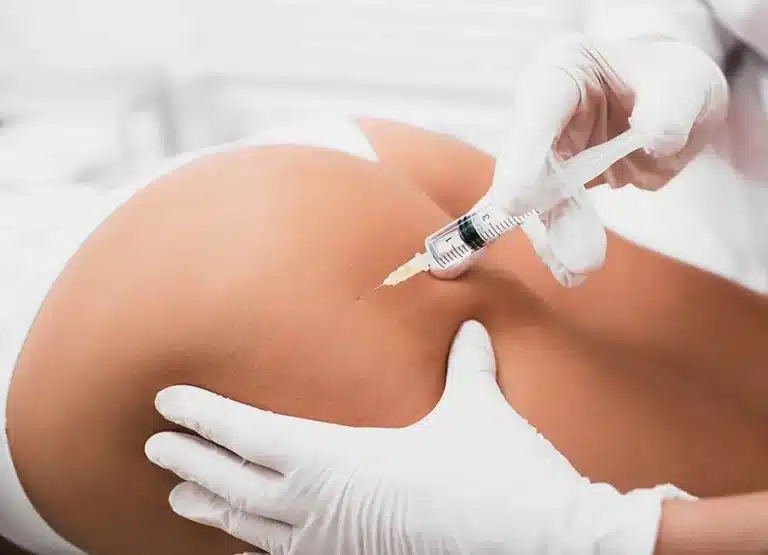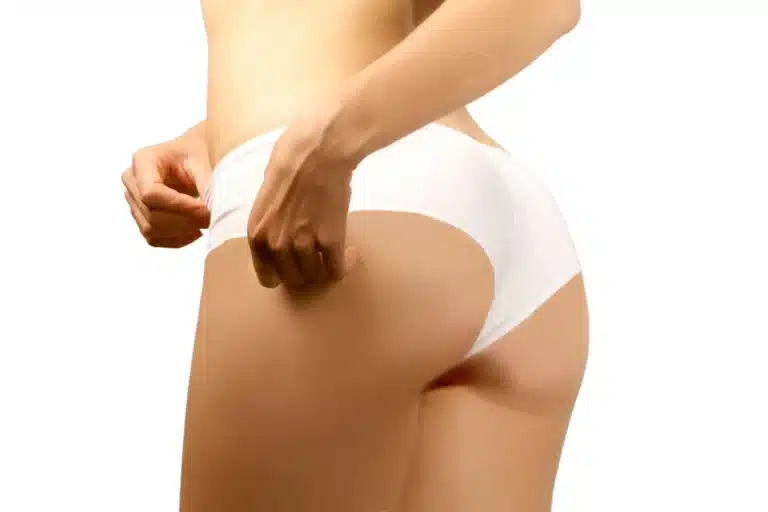Home » Conditions » Body » Hip dips
Hip dips, also known as hollow hips or violin hips, refer to a natural indentation located on the sides of the hips, just below the hip bone. This is a physical trait many people have due to their bone structure and the distribution of body fat. Although this appearance is completely normal and natural, some individuals may feel self-conscious about their hip dips and wish to reduce or correct them. In aesthetic medicine, several non-invasive and effective solutions are available to fill hip dips and enhance the shape of the hips — without surgery.
Les hip dips, aussi appelés creux des hanches ou hollow hips, sont des indentations naturelles situées entre les hanches et le haut des cuisses, souvent visibles même chez les personnes minces. Bien que totalement normales, certaines patientes recherchent des solutions pour obtenir une silhouette plus ‘lisse’ et des courbes harmonieuses. Il est désormais possible de corriger les hip dips sans chirurgie, à l’aide
d’injections d’acide hyaluronique, de Sculptra, et de techniques de remodelage corporel non invasives, notamment la cryolipolyse. Ces traitements permettent de combler les creux, de remodeler les hanches et d’obtenir une silhouette galbée et féminine, avec des résultats naturels et durables.

Les hip dips sont principalement dus à des facteurs anatomiques, notamment la structure du bassin et la distribution de la graisse corporelle.
The main causes of their appearance are :
• Structure osseuse : la forme des os du bassin détermine en grande partie l’apparition des hip dips. Chez certaines personnes, l’espace entre l’os de la hanche et le fémur est plus creux, ce qui crée une dépression au niveau de cette zone.
- Fat distribution: the distribution of fat around the hips also plays a role. Some people have less fat in this area, which makes hip dips more visible.
- Musculature: the musculature of the buttocks and thighs also influences the appearance of hip dips. Weak muscular development can accentuate these hollows.
- Heredity: as with many physical characteristics, hip dips can be hereditary. If several members of your family have them, there's a good chance you will too.
Si certaines personnes les acceptent totalement, d’autres souhaitent atténuer les hip dips pour obtenir une silhouette plus harmonieuse. Plusieurs traitements non invasifs permettent de combler ces creux sans recourir à la chirurgie.
These methods are safe, painless and require little or no recovery time, making them attractive to patients who want a quick and effective solution.

One of the most popular solutions to treat hip dips is the injection of body-formulated hyaluronic acid , such as Hyacorp.
This non-invasive treatment is increasingly used to add volume to areas of the body that lack it.
Hyacorp is injected into the hip dips to restore lost volume and fill in the indentations.
The procedure is non-surgical, gives immediate and natural results, and is quick, minimally painful, and requires no recovery time.
Hyaluronic acid is naturally present in the body and is well tolerated.
Results are visible immediately after the session and continue to improve over the following days.
They typically last between 12 and 18 months, depending on the patient’s metabolism and lifestyle.

Sculptra est un produit qui stimule la production de collagène dans la peau et les tissus sous-cutanés. Il est souvent utilisé pour raffermir la peau et redonner du volume à certaines zones du corps, dont les hip dips.
Le Sculptra contient de l’acide poly-L-lactique, un composant biocompatible qui, une fois injecté, stimule progressivement la production de collagène naturel. Cette production continue permet de combler les creux au niveau des hanches tout en renforçant la structure cutanée.
Contrairement aux fillers classiques qui donnent un volume immédiat, le Sculptra agit progressivement. Le résultat est plus naturel et durable, avec un effet qui se maintient jusqu’à deux ans.

La présence des Love handles peut aggraver le creux des hip dips. La réduction des poignées d’amour par cryolipolyse améliore donc les hip dips. Cryolipolysisis a non-invasive technique that uses cold to target and eliminate fat cells over the long term.
Depending on the size of the fat deposits, one to three sessions are required. The first results are visible one month after the procedure, and the final results three months later. The results are definitive.
Bien que les techniques médecine esthétique soient efficaces pour combler les hip dips, certaines personnes préfèrent essayer d’atténuer ces creux naturellement, en réalisant des exercices de musculation ciblés.
Exercises that strengthen the muscles of the buttocks and hips can help improve these hollows. The most effective exercises include squats, lunges, gluteal bridges and hip abduction exercises.
L’entraînement musculaire permet de raffermir les muscles autour des hanches et peut, dans certains cas, atténuer visuellement l’apparence des hip dips.
En médecine esthétique il existe des solutions non invasives et efficaces pour corriger les hip dips de manière naturelle et sans risque. Les principaux avantages de ces techniques sont :
• Rapidité des résultats : les résultats des injections sont immédiats ou quasi immédiats, ce qui permet aux patients de constater rapidement une amélioration de leur silhouette.
• Aucune période de convalescence : contrairement aux solutions chirurgicales, les injections ne nécessitent pas de temps d’arrêt. La reprise des activités habituelles se fait immédiatement après la séance.
• Résultats naturels : les traitements non invasifs permettent d’atténuer les hip dips de façon progressive et harmonieuse, sans altérer l’aspect naturel de la silhouette ni donner l’impression d’une modification artificielle.
- Personalisation: the treatment can be tailored to the patient's needs to obtain a tailor-made result.
The price of hip dip correction in Geneva depends on the chosen method and the amount of product required to achieve a balanced, harmonious result. When reshaping is performed using hyaluronic acid injections (Hyacorp), the price is 300 CHF per syringe. Several syringes may be needed depending on the patient’s morphology.
If the protocol includes Sculptra — known for its ability to stimulate collagen production and gradually restore volume — the cost is 900 CHF per vial. The number of vials needed depends on the depth of the hollow.
Cryolipolysis may also be proposed as a complementary or preparatory option, in certain cases, and is priced at 500 CHF per session. It can help refine body contours before or after volume restoration.
A detailed quote is provided during the consultation, based on the patient’s aesthetic goals and individual anatomy.
Les hip dips, ou “creux des hanches”, sont principalement déterminés par la structure osseuse du bassin et la manière dont le muscle et la graisse sont distribués autour de celui-ci. Ces caractéristiques sont largement influencées par la génétique. Ainsi, la présence et la visibilité des hip dips dépendent davantage de votre anatomie que de votre masse musculaire.
Le choix de traiter les hip dips dépend des préférences esthétiques personnelles et de l’anatomie individuelle. Une consultation avec un médecin permettra d’évaluer la morphologie du patient, ses attentes et de déterminer si un traitement est approprié.
Les injections d’acide hyaluronique pour combler les hip dips sont généralement bien tolérées. Une anesthésie locale ou une crème anesthésiante est souvent appliquée pour le confort du patient pendant la procédure. Les patients peuvent ressentir une légère pression ou un inconfort temporaire au site d’injection.
Oui, les asymétries des hip dips peuvent être corrigées grâce à des injections ciblées d’acide hyaluronique ou d’autres produits de comblement. Ces traitements permettent d’harmoniser les contours des hanches en comblant les creux de manière précise.
Les traitements non invasifs, tels que les injections d’acide hyaluronique, peuvent significativement atténuer l’apparence des hip dips. Cependant, le degré de correction dépend de l’anatomie individuelle et des attentes du patient. Dans certains cas, plusieurs séances peuvent être nécessaires pour obtenir le résultat souhaité.